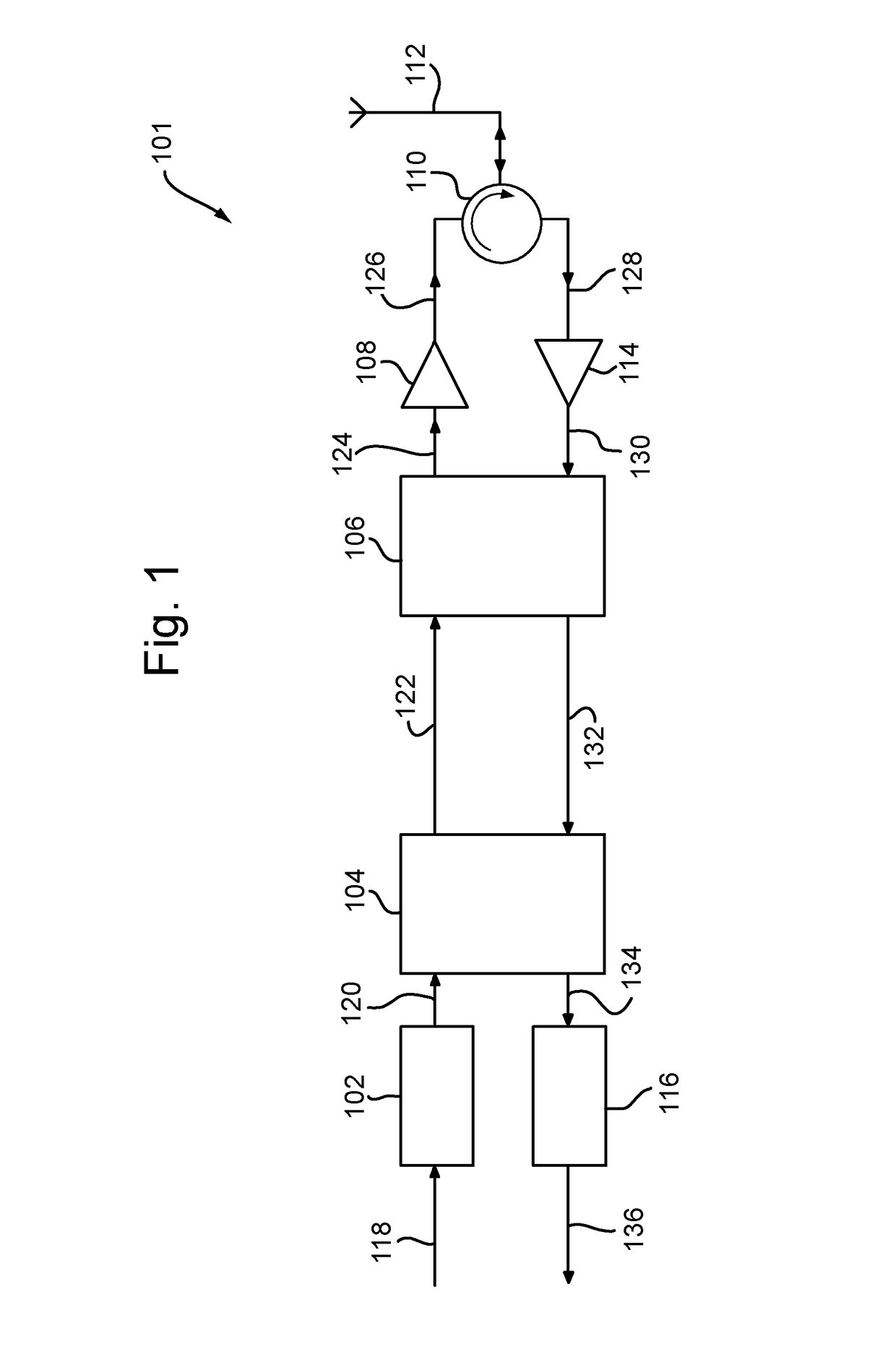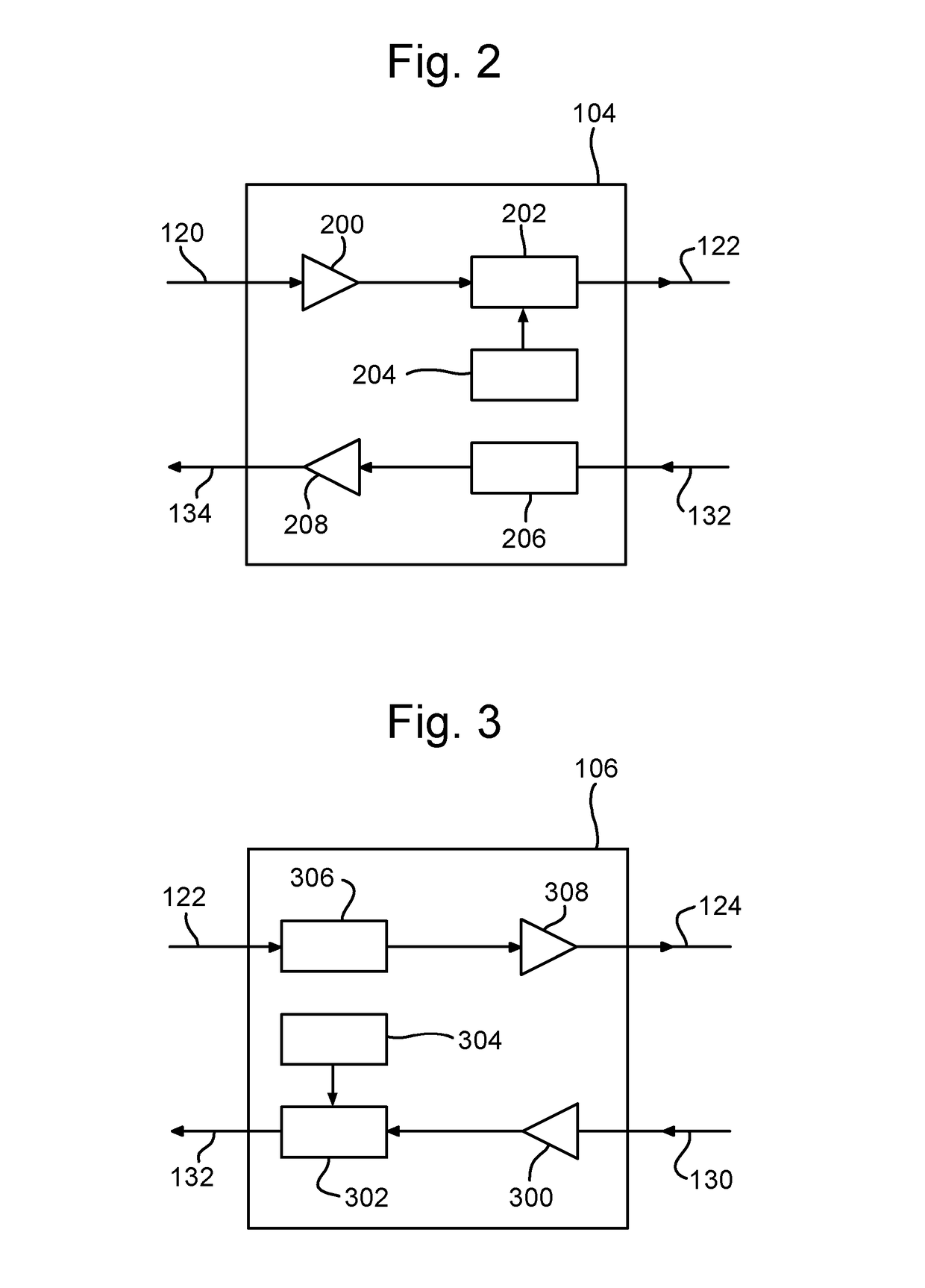Signal processing apparatus
a technology of signal processing and processing equipment, which is applied in the direction of fibre transmission, aircraft components testing, electromagnetic transmission, etc., can solve the problems of loss of signals carried by such coaxial cables, heavy coaxial cables, and low signal quality, and achieves space and weight saving, light amplifiers, and low power
- Summary
- Abstract
- Description
- Claims
- Application Information
AI Technical Summary
Benefits of technology
Problems solved by technology
Method used
Image
Examples
first embodiment
[0042]FIG. 1 is a schematic illustration (not to scale) of a signal transmitting / receiving system 101. In this embodiment, the system 101 is implemented on-board (i.e. located within and / or mounted on) an aircraft, as described in more detail later below.
[0043]The system 101 comprises a transmit signal processing module 102, a first optical-electrical conversion module 104 (hereinafter referred to as the “first optical module”), a second optical-electrical conversion module 106 (hereinafter referred to as the “second optical module”), a power amplifier 108, an electrical circulator 110, an antenna 112, a low-noise amplifier 114, and a receive signal processing module 116.
[0044]What will now be described is an example operation of transmitting and receiving signals by the system 101. The couplings and connections between the modules and elements of the system 101 will also be described. In the below description, reference is made to FIG. 2, which shows further details of the first op...
second embodiment
[0082]What will now be described is a signal transmitting / receiving system, hereinafter referred to as the “further system”, in which a single optical fibre that provides both transmit and receive channels for multiple antennas.
[0083]FIG. 5 is a schematic illustration (not to scale) of the further system 501. In this embodiment, the system 501 is implemented on-board the aircraft 400, as described in more detail later below. In the Figures, like reference numerals designate like parts.
[0084]The further system 501 comprises the modules and connections of four of the systems depicted in FIG. 1 and described above. The four systems 101 are coupled together as described in more detail later below to provide four transmit / receive channels.
[0085]In this embodiment, in addition to the modules and connections of four individual systems 101, the further system comprises a first wavelength division multiplexer / de-multiplexer 502 (hereinafter, the “first WDM”), a second wavelength division mul...
third embodiment
[0120]In this third embodiment, the signal transmitting / receiving system is implemented on the aircraft 400.
[0121]FIG. 6 is a schematic illustration (not to scale) showing modules and apparatus located at the equipment bay 416 in the third embodiment. The modules and apparatus shown in FIG. 6 are hereinafter collectively referred to as the “equipment bay modules” and indicated using the reference numeral 601.
[0122]FIG. 7 is a schematic illustration (not to scale) showing modules and apparatus located at the wing bays 418 in the third embodiment. The modules and apparatus shown in FIG. 7 are hereinafter collectively referred to as the “wing bay modules” and indicated using the reference numeral 701.
[0123]In this third embodiment, the wing bay modules 701 including the antennas 112a-d are configured to operate with RF signals within all of the four communication bands (BANDS 1-4). Thus, the wing bay modules 701 in this third embodiment may be wider bandwidth than those used in, for ex...
PUM
 Login to View More
Login to View More Abstract
Description
Claims
Application Information
 Login to View More
Login to View More - R&D
- Intellectual Property
- Life Sciences
- Materials
- Tech Scout
- Unparalleled Data Quality
- Higher Quality Content
- 60% Fewer Hallucinations
Browse by: Latest US Patents, China's latest patents, Technical Efficacy Thesaurus, Application Domain, Technology Topic, Popular Technical Reports.
© 2025 PatSnap. All rights reserved.Legal|Privacy policy|Modern Slavery Act Transparency Statement|Sitemap|About US| Contact US: help@patsnap.com



